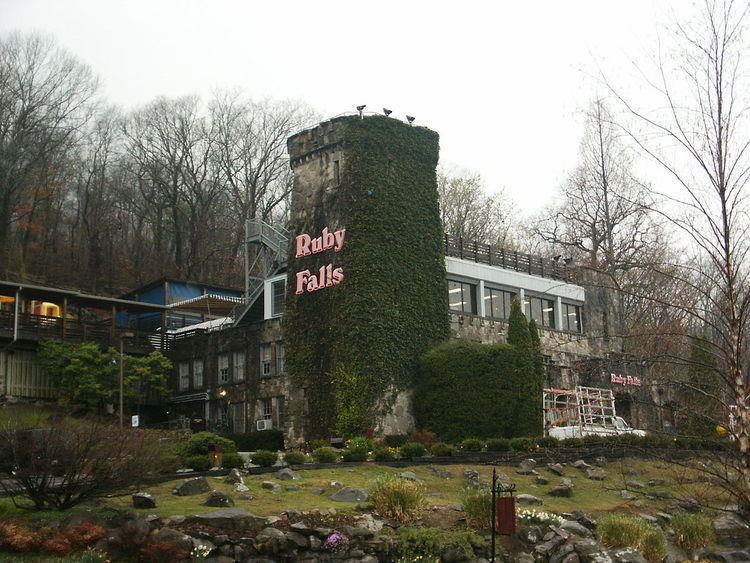Area 10 acres (4.0 ha) NRHP Reference # 85002969 | Built 1929 Added to NRHP November 26, 1985 | |
 | ||
Architect Lambert,Leo B.; Brown Contracting Co. | ||
Ruby Falls is a 145-foot high underground waterfall located within Lookout Mountain, near Chattanooga, Tennessee in the United States.
Contents
Geology
The cave which houses Ruby Falls was formed with the formation of Lookout Mountain. About 200 to 240 million years ago (in the Carboniferous Period, at the end of the Paleozoic Era) the eastern Tennessee area was covered with a shallow sea, the sediments of which eventually formed limestone rock. About 200 million years ago, this area was uplifted and subsequent erosion has created the current topography. The limestone in which the cave is formed is still relatively horizontal, just as it was deposited when it was below sea level. The Lookout Mountain Caverns, which includes Ruby Falls Cave, is a limestone cave. These caves occur when slightly acidic groundwater enters subterranean streams and slowly dissolves the relatively soluble limestone, causing narrow cracks to widen into passages and caves in a process called chemical weathering. The stream which makes up the Falls entered the cave sometime after its formation.
Ruby Falls Cave features many of the more well-known types of cave formations (or speleothems) including stalactites and stalagmites, columns, drapery, and flowstone.
The Falls are located at the end of the main passage of Ruby Falls Cave, in a large vertical shaft. The stream, 1120 feet underground, is fed both by rainwater and natural springs. It collects in a pool in the cave floor and then continues through the mountain until finally joining the Tennessee River at the base of Lookout Mountain.
While Ruby Falls Cave combines with Lookout Mountain Cave to form the Lookout Mountain Caverns, the two caves were not actually connected by any passage. Ruby Falls Cave is the upper of the two and contains a variety of geological formations and curiosities which Lookout Mountain Cave does not have.
History
Ruby Falls Cave, unlike Lookout Mountain Cave, had no natural openings and could not be entered until the 20th Century; it therefore does not have the various artifacts which are often associated with caves in the southeastern United States. In 1905 the natural entrance to Lookout Mountain Cave was closed during the construction of a railway tunnel. In the 1920s a chemist and cave enthusiast named Leo Lambert thought that he could re-open the cave as a tourist attraction, and formed a company to do so. He planned to make an opening further up the mountain than the original opening and transport tourists to the cave via an elevator. For this purpose, his company purchased land on the side of Lookout Mountain above Lookout Mountain Cave and in 1928 began to drill through the limestone. In doing so, they discovered a small passageway about 18 inches high and four feet wide. Exploring this opening, Lambert discovered the formerly hidden Ruby Falls Cave and its waterfall. On his next trip to visit the cave, Lambert took his wife Ruby, and told her that he would name the falls after her.
In 1954, the pathway around the basin was cut in order to allow tourists a better view of the falls. This began the tour-related quip regarding not drinking the falls' water. Though pure and thus safe to drink, it has large concentrations of magnesium from the strata of the mountain, which makes it a natural laxative.
In 1975, the secondary exit from the falls to the base of the mountain was cut. This was to comply with recreation regulations in Tennessee. The secondary exit is used in the event that the main shaft elevator fails. This secondary exit is used for the popular "Ruby Falls Haunted Cavern" which is an event for late September, through October.
In April 2007, the National Speleological Society (NSS) published "Caves of Chattanooga" by Larry E. Matthews. Chapter 3, "Ruby Falls Cave", covers the history of Ruby Falls Cave from its discovery in 1928 through 2007 (includes 23 illustrations). Chapter 1, "Lookout Mountain Cave", covers the cave Leo Lambert was drilling for when he accidentally discovered Ruby Falls Cave.
Tourism and advertising
Lambert decided to open both caves to the public, although Lookout Mountain Cave was closed in 1935 since it was not very popular with tourists, who were much more impressed with the upper cave. Public tours began in 1930. Electric lights were installed in the cave, making it one of the first commercial caves to be so outfitted. Motorists travelling on I-75 in the 1970s and 1980s were subjected to dozens - maybe hundreds - of billboards along their route with the words "SEE RUBY FALLS" beginning hundreds of miles north and south of the falls itself. Ruby Falls remains a staple of Chattanooga tourism, operating daily. Ruby Falls is owned by the Steiner family of Chattanooga, Tennessee.
Ruby Falls and the larger Lookout Mountain Caverns complex have been designated a National Historic Landmark. It is often associated with the nearby Rock City attraction, which lies atop Lookout Mountain.
